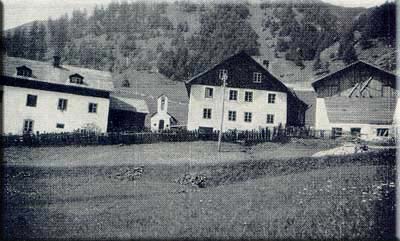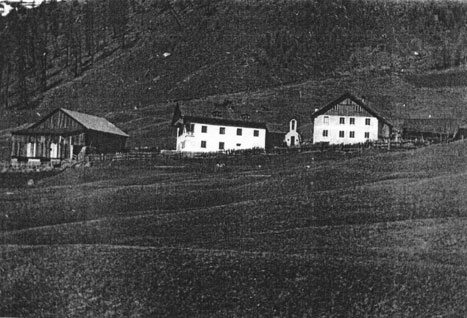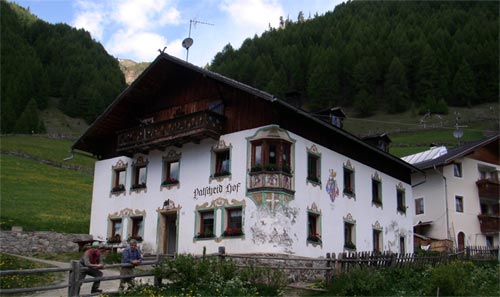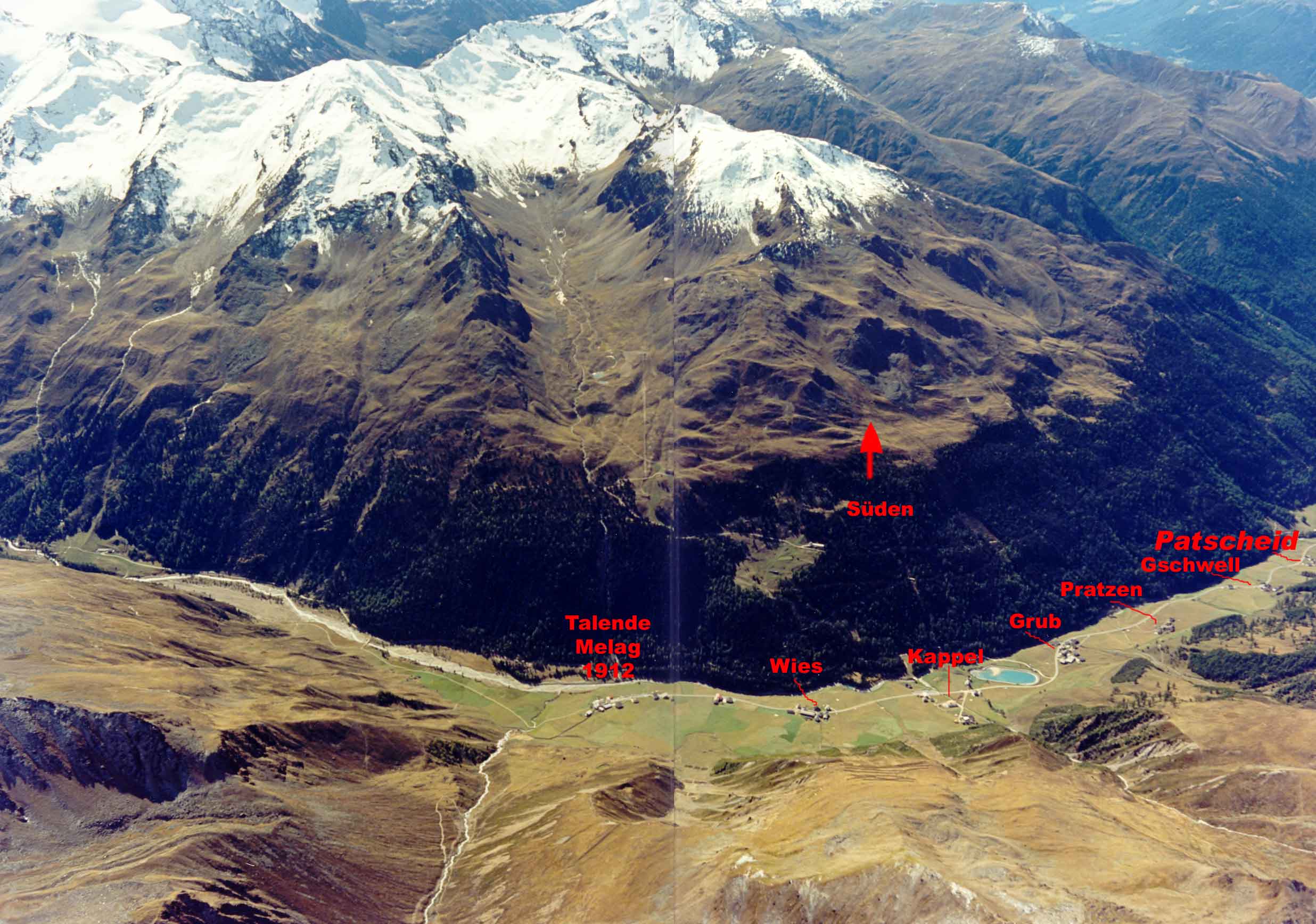The "Patscheidhof" (old farm) in the vally of Langtaufers (South Tyrol, Italy)
There are multiple Patscheid farms, including one in the Langtaufer valley (which is being discussed here), one in Paznaun (information is currently unknown), and one in Signat near
Bolzano (located in South Tyrol, Italy) on the Riten. Although no longer owned by the Patscheider family, the name has been preserved as the farm name. For a long time, this farm was a
great family-run restaurant with South Tyrolean specialties, but is currently closed.
Here only the farm in the vally of Langtaufers is referred to and discussed:
It's important to note that the original form of the Patscheidhof no longer exists, as it was rebuilt around the turn of the century (ca. 1906). Although owned by the Thöni
family today, it still displays the name "Patscheidhof" on the front.
The Patscheiders, whose ancestry can be traced back to Claus Patscheidt (born 1497), have spread not only throughout Tyrol but also across half of Europe, as well as on other continents.
The Patscheidhof is home to the first documented Patscheider.
In earlier times, a farm such as this was nearly a small settlement comprised of multiple dwellings and farm buildings. It was managed by several families, with usually 3 to 4
generations living on one farm.
If we assume that the average number of children at that time was around 5 per marriage, we can estimate that such a farm was home to about 50 to 100 people.
The Patscheidhof in the valley of Langtaufers is a sister farm of the Gschwellhof, separated only by a stream (s'Gschwell). The two farms have a close connection, and it was not
uncommon for inhabitants to move from one farm to the other.
Dissertation from Engelbert Waldner:
The main source of my knowledge is a dissertation by Engelbert Waldner from 1950, in which the Patscheidhof is examined
in more detail.
For this page, I have copied the relevant passages of the dissertation, a copy of which is available to me. I have only
adapted the spelling of general words to today's conditions and corrected obvious typing errors. I have translated the text
to english. The wording has been taken from the original german text. In order to clearly distinguish the monetary values
from the dates, I have added thousand points and a decimal point to the monetary values. The currency is guilder,
the abbreviation for guilder is given as "fl".
Beginning Excerpt from: "a contribution to the historical regional studies of South Tyrol" Dissertation
for obtaining the philosophical doctorate at the Leopold-Franzens-University of Innsbruck. Submitted in January 1950
by Engelbert Waldner:
C. Settlement history -> 3. farm genealogies -> Patscheidhof
Patscheid, the original farm of the widespread clan of Patscheider, comprises two stately houses and is situated
at 1803m above sea level.
The Patscheidhof is probably already listed in 1317 in the account of the Haupold Passeier among the properties of
the sovereign, but it is not the one in Langtaufers, but the farm of the same name in Paznaun. In 1450 this farm is again
listed among those of the sovereign, but this time it is explicitly mentioned that it was located in Paznaun.
The Patscheidhof in Langtaufers is mentioned for the first time in 1448 among the former Starkenberg estates. The
interest for this farm at that time was 28 Schot cheese and 4 Schot lard, the same interest is also stated in the Urbar
of the year 1466. In 1522 it appears under the title "Starckenberger Zins".
In this year 1522 Hans von Patschayd is mentioned as the owner of the farm, it is probably the father of Claus
Patscheider, who was the owner of the farm until 1564. In this year the father gave the whole Patscheidhof to his three
children Paul, Florian Patscheider and Hans Wadeller for his wife Anna Patscheiderin which the parents reserved the
usufruct from a part of the farm until their death. In the following period, however, there is only talk of Paul
Patscheider, presumably he acquired his siblings share of the farm, so that a division was avoided. This Paul Patscheid
died in 1584 and left three sons named Veith, Thoman and Pauli, as well as two daughters, Ursula and Barbara. After the
death of Pauli, half of the farm must have been sold, because in 1598 Sigmund Stecher owned half of the farm at Patscheid,
while the other half was owned by the eldest son of Pauli, Veith Patscheider. We will then find the second oldest at the
"Gschwellhof", as the first representative of his clan on this farm. In 1635 Christian Stecher, the son of
Sigmund, died childless.
In 1636 Simon Stecher, a brother of Christian, and Fliri (Florian) Patscheider appear as owners of the Patscheidhof.
1649 were Florian Wadeller and Florian Patscheider.
In 1649 Wadeller exchanged his half farm to Hanns Lenntsch.
In 1670 Fliri Patscheider died and left three children, Christian, Florian and Katherina.
Hanns Lenntsch kept his half of the farm until 1683, when he exchanged it with Thoman Joss. Four years later the owner
changed again, Gregori Plangger acquired the Joss farm half for 1,540 fl. From this half of the farm four days of meadow
had been sold in 1674.
In 1710 Pauli Patscheider sold Josef Folie a farm share in Patscheid, as he had acquired it from Gregori Plangger.
This was the only line I could follow up to here. But while already here the clans changed frequently - in a little more
than hundred years 7 different family names - so I face a confusing jumble of sales, divisions and exchange contracts, which
make a coherent representation impossible regarding the other farm shares since the second half of the 17th century.
In the course of the 17th and 18th centuries, several dwarf estates developed, which then often passed from hand to
hand as rolling estates in rapid succession. This seems strange to us, when on the neighboring Gschwellhof, in contrast
to this, we will find a certain clear line in the sequence of ownership. I will now list individual changes of ownership,
and from the indicated purchase sum one will be able to deduce the size of the estate:
1637: Veith Patscheider's heirs sell their joint property to Hans Patscheider, innkeeper at Tschamppen in Reschen,
for 540 fl.
1676: Christian Patscheider leaves his brother Florian from a farm 1/3 dwelling, barn, stable, a field and a piece
of land for 376, - fl. 1682 Florian Patscheider sells this to Jakob Mayr.
1684 Georg Follie sells to his brother-in-law Veith Patscheider as much meadow as one can mow in 4 days as early
meadow for 463,- fl.
In 1699 Thoman Folie sold Hanns Patscheider at the Gschwellhof as much meadow as one can mow in 3 days for 339,- fl.
1703: Christian Stecher sells to Christian Theni, master tailor, half a dwelling, barn and stable, half of 1 Muth, 3
Mezen seed field and as much meadow as one can mow in 2 days for 292, - fl.
1705: Christian Baumgartner's children sell to Christian Theni 1/4 dwelling, barn and stable, a piece of field and meadow
for 175,- fl.
1710: Katharina Bedrossin leaves a "Gietl zu Patscheid" to Thoman Patscheider for 520,- fl.
1710: Johannes Blass exchanges his estate at Patscheid with that of Jakob Franck at Pedross.
1725: Thoman Patscheider sells his "Gistl" to the "fürnemben" Christian Follie, a court-ordered servant,
at the Grubhof for 431,- fl.
1728: Thoman Patscheider sells to Clemens Pämgarter from his still owning "Haimbetly" the half for 530,- fl.
1728: Maria Mallsauerin sells the property to her son Anthoni for 745,- fl.
1739: Christian Fritz sells Johannes Danäll a "Gietl" at Patscheid for 382,- fl.
If one now considers that around 1700 an average farm in the valley cost about 1,200 to 1,500 fl., one can get an
idea of the size of these dwarf estates.
A good overview of the ownership situation can be found in the main and stock register from 1740. At that time there
were 4 dwellings in Patscheid.
The property of the Patscheidhof is shared by the following people:
Christian Follie Jr: 1/2 dwelling, about a quarter of the goods.
Anthoni Franck: 1/2 house and not quite a quarter of the farm estates.
Johannes Tanall: 1 dwelling and 5 days meadow.
Thoman Patscheider's widow: 1/2 dwelling and 2 days mown meadow.
Nikolaus Warger: 1/2 dwelling and a little garden.
Maria Patscheiderin: 1/2 house, as much meadow as you can mow in a day, 1 easure of grain Acker.
Johannes Pämgartner: 1 days mown meadow, 1 measure of grain field.
Clement Pämgartner: 1/2 dwelling, 2 days mown meadow, 1 measure of grain field.
Gabriel Patscheider, Michael Eller and Florian Eller each own 2 days mown meadow.
Michael Eller and Hans Patscheiders children together a field.
In the next centuries we can observe a somewhat retrograde movement, I suppose that between 1740 and 1775 a fire
catastrophe incinerated the whole hamlet, because in 1775 there were only 2 houses to Patscheid compared to 4 in 1740.
In 1775 a large part of the farm was in the hands of the:
Gabriel Follie: a whole dwelling, 3/4 yoke field, 13 days mowing early and 5 days mowing late meadow.
Florian Patscheider: 1/3 dwelling, 1/8 yoke field and 4 days mown meadow.
Christian Theni: 1/3 dwelling, 1/8 yoke field and 4 days mown meadow.
Michael Baumgartner: 1/3 dwelling, 1/8 yoke Acker und 4 days mown meadow.
Jakob Warger: 1/6 dwelling alone.
In 1809 Gabriel Follie's property passed to his son Martin, who had taken it over from his father in 1778.
In 1876 Johann Eller sells his farm estate at Patscheid to Josef Theni, farmer's son at Gschwell.
In 1894 Johann Folie left his farm at Patscheid to his son Otto for 3400 fl.
Today (1950) two, respectively three well-situated farmers share the whole Patscheidhof.
We can still find the Folie there today. We saw the first representative of this clan on the Patscheidhof in Josef
Folie in 1710.
Today (1950) Gabriel Folie, the son of Isidor, owns the whole dwelling No. 60 alone, 56a 36m field and 3 ha 96a
91m meadow. The two cousins Johann and Josef Theni share the other dwelling. The estates are merged because Joseph is
childless. Josef owns besides the half house 22a 41m arable land, 1ha 96a meadow and Johann 30a 4m arable land
and 3 ha 32a 96m meadow.
End Excerpt from: "a contribution to the historical regional studies of South Tyrol" Dissertation for
the attainment of the philosophical doctorate at the Leopold-Franzens-University of Innsbruck. Submitted in January 1950
by Engelbert Waldner.




